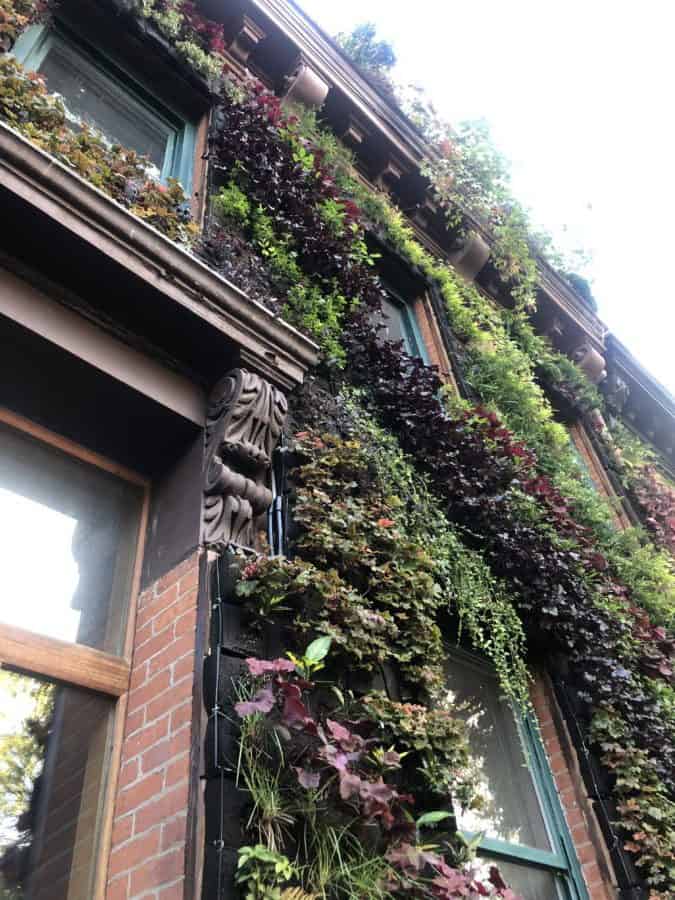As more people move to urban areas and the effects of climate change increase steadily, it is not surprising that global warming is expected to worsen in the future. Translation: Urban Heat Island Effect is just going to get worse. As living wall installers in New York, our main interest is in how living living walls can help mitigate heat island effect of New York City, but since green roofs have been around for some time, much more research has been done on them and we are forced to extrapolate meaning for living walls.
Below are facts about green roofs of some studies we read. From them it is clear that outdoor living walls will have a similar effect on a building, namely to help cool it in the summer.
Two ways were studied. One way to counter this heat and cooling is to plant different types of vegetation to form a green roof. Another option is to paint the roof surfaces in white, as is customary in the Mediterranean, called cold roofs.
These simple measures can go a long way in helping to reduce the urban heat island effect, where built-up areas experience higher air temperatures than rural areas because of the high density of buildings that retain heat. As you can imagine, this leads to an increase in overheating and energy consumption (due to the use of air conditioning) in buildings in the summer.
The roofs of office buildings in most cities are often flat and unused, leaving sufficient space for plants or for simple white painting. In a study we examined the effectiveness of these measures in an office in London.
Cool passive options
We have established that the amount of heat experienced by an office worker can be reduced by installing a green or cold roof without the need for additional air conditioning. To explain the results in more detail, we need to understand how these roofs work.
A green roof reduces the amount of solar energy entering the building and provides extra insulation. The air directly above the plant layer is cooled, depending on whether the vegetation is sufficiently watered or not. Dry roof plants provide less cooling than irrigated plants, which can be a disadvantage for drier summers of the future.
Cool roofs are usually painted white because lighter surfaces reflect more light than dark ones. This lowers the surface temperature and air temperature and less heat energy enters the building. The quality of the white painted roof depends on the weather conditions. A building in Boston, USA, which has hot summers and cold winters, saved slightly more energy from heating and cooling by doubling the insulation (13%) compared to setting up a green roof (12%). But a similar building in Lisbon, Portugal, with hot summers and warm winters, made energy savings of 26% possible with a green roof, while insulation made almost no difference (0.01%).
In an attempt to determine how far the air had cooled just above the factories or the white-painted roof, we looked at a certain area around Victoria Station in London – an area that was marked as a potential site for green and cool roofs.
Our results showed that a cool roof was the most effective way to lower the air temperature during the day, when the solar energy was at its peak, while a green roof reduced the temperature of the air, especially during the evening. The cooling effect of a green roof takes longer, but both have a cooling effect on the local environment and reduce the effect of the urban heat island. It is essential to understand the net effects of green and cool roofs to predict how they will change urban temperatures.
A hot future
Using a simulation, researchers looked at the overheating point – the level at which the residents of the building felt extremely hot – in typical office buildings in two possible climate scenarios, one in the current climate and the other in the expected climate of 2040-2069.
For the current model, without the addition of a cool or green roof, the office building overheated 8% of the occupancy hours during the summer period. After adding a cold or green roof, the number of occupied hours was reduced to less than 3%, with the cool roof being the most efficient. In the future climate scenario the building overheats about 25% of the time – a considerable amount – but with the addition of a green or cold roof, the overheating has been reduced to 14% and 11% respectively of the occupied hours.
Research shows that office buildings without the addition of measures to counter the heat are likely to become too hot in the summer, against the temperatures of 2050. That is why UCL is currently working to show exactly how the influence of the city climate is influencing on buildings. This research will also develop guidelines for addressing these problems.
This study, along with other related studies, shows how in a changing climate, new and innovative designs need to be considered to ensure comfortable temperatures without excessive energy consumption. The current projects at UCL continue to explore the nature of urban climate change and sustainable ways to tackle the problem.
The Takeaway as New York Living Wall Installers
As outdoor living wall installers we can presume from these studies that exterior living walls will have similar effects on building walls as green roofs have on building roofs. It is our experience that a south facing wall in New York will be considerably cooler with an exterior living wall installed on it, thus reducing the heat of the building and the overall heat island effect of the area.
These studies, although not directly about exterior living wall installations, indirectly show how an an outdoor living wall will effect a building. It is clear to us that living walls are an important technology in helping reducing individual buildings cooling loads as well as the heat island effect of the surrounding neighborhood.


